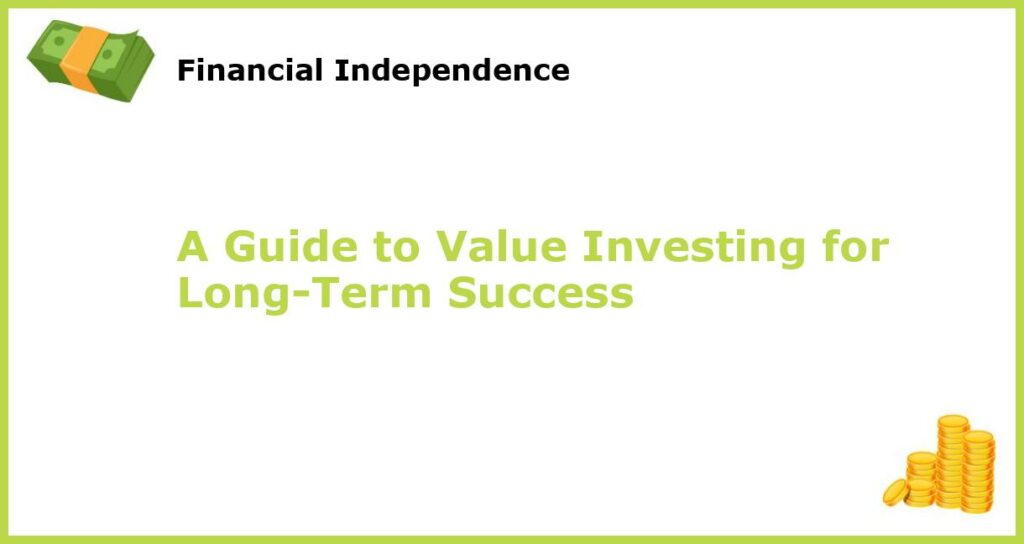Welcome to the world of investing! Whether you’re an experienced investor or you’re just starting out, value investing can be a great approach to achieving long-term success. If you’re unfamiliar with this strategy, have no fear! We’ll break down the key elements of value investing and give you some tips to get started on the path to long-term success.
1. Understanding Value Investing

Value investing is a time-tested investment approach that was popularized by Benjamin Graham and has been successfully used by investors such as Warren Buffet. The core principle of value investing is to buy securities below their intrinsic value, creating a margin of safety for the investor. This approach requires patience and discipline, but it has the potential to lead to great long-term success.
Investors interested in value investing are primarily looking for bargains in the stock market. Instead of buying popular companies whose stock prices may be inflated, value investors seek companies whose stocks are undervalued by the market. They buy these stocks with the expectation that market inefficiencies will eventually correct themselves, and the stock price will rise to reflect the company’s true worth. Patience is key here because this process can take months, if not years.
Additionally, value investing often involves buying and holding investments for the long haul. In general, value investors are not interested in making quick profits or timing the market. Instead, they look for stable but undervalued companies whose long-term future seems secure. By investing in such a company, they hope to benefit from the company’s growth over time.
2. The Importance of Intrinsic Value

The concept of intrinsic value is essential to value investing. Intrinsic value represents the actual worth of a company, which may differ from its current market value. Once an investor determines the intrinsic value of a company, he can determine whether that company is a good investment. An undervalued stock has a market price that’s less than its intrinsic value.
Investors typically use many different methods to calculate intrinsic value. This approach includes analyzing various financial statements such as income statements, balance sheets, and cash flow statements. Management quality and opinions, industry trends and comparisons, and other financial ratios based on historical and projected fundamentals can also come into play.
The crucial factor is that the intrinsic value should be higher than the current market price, representing a discount. If the investor does this analysis right, an undervalued company can reap significant profits over time.
3. Conducting Fundamental Analysis

Fundamental analysis is the approach of analyzing companies’ financial statements, management styles, and the marketplace to discover the intrinsic value of a company. Value investors use this type of analysis when considering a possible investment. They research companies and determine their worth based on specific factors unique to that company.
Fundamental analysis considers the big picture but also assesses the details. This method can help investors forecast how a company will perform in the future. Additionally, an analysis can confirm if a company is undervalued or overvalued by the market.
Although this analysis can be time-consuming, investors can confidently make their own decisions about buying or selling securities, instead of relying solely on the advice of others.
4. Knowing When to Buy and Sell

Timing can be crucial in value investing. Ideally, an investor will buy a security when it’s undervalued and then sell it once its price has risen sufficiently to reflect the true worth of the company. The trick is knowing when to buy and when to sell.
Generally, value investors try to buy when the market is exceptionally pessimistic, and stocks are undervalued. When the market and economy are doing well, these investors can sell and cash in on their gains. This method can be helpful in the long run, enabling long-term investors to profit from market volatility and uncertainty.
Selling too early, however, can limit potential long-term gains. On the other hand, waiting too long to sell also carries risks that a company’s stock may decline in value again. Thus, investors should have a disciplined approach to timing their buying and selling decisions.
5. The Importance of Patience

Patience is a vital virtue in value investing because good investments may not produce returns immediately. It can take time for the market to recognize the true value of a company. As a result, value investors must practice patience.
Exercising their patience can mean holding onto an investment that may appear to be losing value when the rest of the market rises. Trust in the research and methodology is necessary to reap the benefits of value investing fully.
Despite the potential for slow returns, value investing offers significant potential gains. Patience is critical during this – often long – waiting period.
6. Looking for a Margin of Safety

A margin of safety is a buffer between the actual value of a company or asset and its market price. This margin provides the investor with an additional layer of protection. The market price of an asset can be volatile, and the margin of safety can protect against unexpected events that may affect that asset’s price.
Investors can use this margin to their advantage when buying a security. If an investor can find an asset with a wide margin of safety, they can limit their potential downside risks. A wide margin of safety can also provide a measure of protection during periods of market volatility or uncertainty.
7. Diversification is Key
Investors must diversify their portfolio to achieve long-term success. Even if an investor conducts thorough research on a potential investment, the market can be unpredictable.
By diversifying across different asset classes and industry sectors, investors can protect themselves from market fluctuations and economic downturns. Instead of relying too heavily on one stock, investors may opt to invest in several assets to lower overall portfolio risk.
Diversification can reduce risk, but it can also limit growth potential. The risk is that an investor could spread themselves too thin and subsequently miss out on significant rewards available in selected investments. Investors may need to review and adjust their diversification strategy regularly.
8. Staying Disciplined
Discipline and patience are crucial traits of a successful value investor. It’s easy to get distracted by market trends and emotional reactions to market swings. However, consistent, rational decision-making is more likely to lead to long-term success.
It’s important to have a clear set of investment criteria to adhere to strictly. Once an investor has identified the most promising investments, they must stick to the plan, even when things may not be going well.
Keeping a log of investments, sticking to one’s strategy, or enlisting expert help, such as a financial advisor, can help investors stay disciplined and achieve better long-term results.
9. Avoiding Emotional Decision-Making
Emotions can lead to rash investment decisions, which can result in a significant decrease in a portfolio’s value. When emotions are running high, some investors decide to buy, others to sell. Typically, these decisions are based on high levels of greed or fear.
To avoid irrational decision-making, investors need to discipline themselves to stick with their investment strategy. This strategy may require sticking to the plan, even when market conditions aren’t ideal, and avoiding the temptation to make emotional decisions that may result in costly mistakes. Investors must always remember the essential principle of value investing: its long-term mindset, and “slow and steady wins the race.”
10. The Importance of Education
Investors must stay informed about market trends and evolution, while also regularly evaluating their portfolio to adjust and optimize their strategy. Continuing educational efforts will help investors make well-informed decisions that can have positive long-term effects.
Reading up on investing, personal finance, and the economy as a whole could be the first step. At the same time, investors should always keep learning about the specific industries and companies they invest in by reading company filings, participating in investor conference calls, or seeking expert guidance from financial advisors. Better research results invariably translate into improved decision-making for investors.







